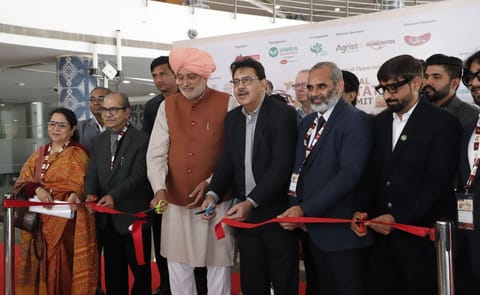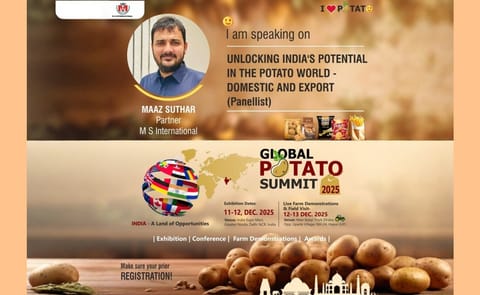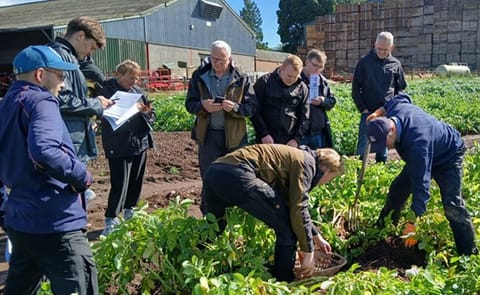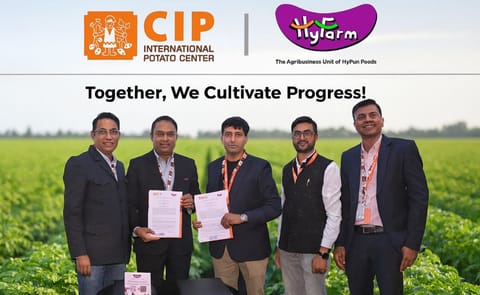Potato Crop Spraying
Scorched by foliar fertilization in the past… reasons to try again

The concept of foliar applied preparations is based on science, but when they were initially introduced in the late 1990’s many of the initial products had drawbacks, such as leaf scorch, low active volumes per application, poor uptake and even phytotoxicity. All of these tarnished the overall concept and commercial uptake of foliar applications, but product developments have made major improvements to the offerings available today.
Over the last thirty years, reams of research have been carried out to address many of these issues, resulting in today’s products that have been developed using modern chemical and biochemical engineering which:
- Has almost eliminated the risk of leaf scorch
- High Nutrient Use Efficiency
- Allows full treatments of nutrients, including nitrogen, in a single dose without scorching
- Allows ‘surgical’ applications of exact doses at precise times
- Are compatible with many additional micronutrients and biostimulants
These advances mean that foliar nutrition can play a full part in the crop nutrition programme and not just a supporting role, where it can be delivered directly onto the crop’s canopy, promoting crop growth and development, seconds after application.
The development of these ‘third generation’ foliar products negates the previous issues and now offers farmers and growers a host of benefits ranging from an overall reduction in the amount of nitrogen, phosphate or other nutrients applied by increased nutrient use efficiency and reductions in environmental losses. This results in overall improvements in yield quality and tonnage for reduced inputs.
Reduction in the total volume of nitrogen required
Work though bodies such as Rothamstead, AHDB and ADAS has shown that nutrient use efficiency (NUE) of soil-applied nitrogen is typically 55% or less for many crops, and even lower for potatoes, due to their shallow and poorly developed root system. Later top dressings are even lower in NUE.
Whereas research has demonstrated time and again that a NUE of 90% or more can be achieved from foliar-applied nutrients, including nitrogen, allowing farmers and growers to reduce their overall nitrogen applications in the region of 8-35%.
This can be realised because it is directly applied to the leaves, bypassing the need for the nitrogen to pass into the soil, where it risks being washed off, volatilisation as ammonia or nitrous oxide, leached through the soil and into water courses.
The newly chemical-engineered formulations allow for increased application rates without the scorch factor – reducing the number of tractor passes required to complete a full treatment.
Immediate uptake
Foliar nitrogen is more effective because plants can absorb these nutrients through the leaf stomata and epidermis quicker that through their root systems. Direct application to leaves means that nutrients are taken up and can be utilised immediately, unlike those that are applied to the soil.
Absorption through the leaf allows utilisation of the applied nutrients quickly when needed, unlike soil-applied nitrogen, which requires rain/dew to dissolve it, allowing it to be transferred to the roots to be absorbed and then transported to the point of use.
Foliar applications are particularly beneficial and ensure a more consistent uptake of nutrients compared to the root system when:
- Evaporation is low
- The soil is too wet/dry (drought conditions)
- The crop is under high pressure due to stress factors (heat/drought).
Nitrogen applications are timed to meet a crop’s increased demand for energy – foliar applications ensures that ‘moment’ is met within minutes and not reliant weather conditions.
Better for the environment
By applying the nitrogen directly to the leaf, the total amount of nitrogen used can be reduced due to the direct absorption and the reduction of wastage that comes with the scatter gun effect of soil applications.
While foliar applications cannot replace all nitrogen inputs, it can be used to replace a large proportion of soil-applied nitrogen after the initial placement at planting because applications can be carried from the 1st leaf growth stage through to harvest.
In nitrate-sensitive areas, run-off caused by direct application to the soil can be avoided, helping to reduce the build-up of nitrates in watercourses and the resulting algae blooms.
Using foliar nitrogen can reduce the number of tractor passes as many foliar-applied products can be delivered together, however, this should always be checked with the manufacturer.
Increased marketable yields
Through independently funded projects, such as the Innovate UK POSTCOVA trial, time and again research has shown that foliar nitrogen applications do not automatically mean a reduction in tonnage or quality. In fact, farm and field trials have shown that marketable yields in some instances have increased by up to 25%.
Improved soil health and sustainability
By feeding the crop rather than the soil, nutrient lockup is avoided, soil health is not impaired through excess chemical applications and nitrate run-off is averted; all small steps that help the environment and contribute to improved financial sustainability.
So, if you were an early adopter of the concept of foliar applications, and you got scorched – now is the time to take another look – in 30 years, R&D has made huge advances. If you haven’t tried it yet – there are many compelling reasons to give it a go.








